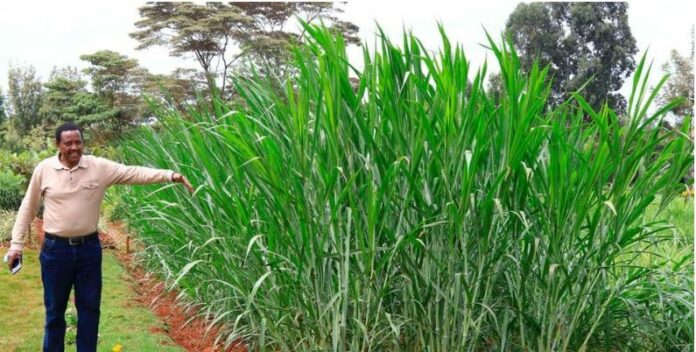Feeding is one of the important aspects of dairy farming as it largely affects the quality of milk produced by the animal.
Dairy cows require a balanced diet for milk production, body maintenance, and good health. The feed given to the cow must be digestible so that the nutrients can be absorbed in the body and should not contain toxic substances.
Fodder crops like Napier grass are considered the most important feed in feeding dairy cattle as they provide energy for body maintenance, milk production, growth, weight gain, and reproduction.
However, to achieve the desired results, it’s important to choose the right Napier grass variety, as experts say ordinary Napier grass lacks sufficient protein and energy, resulting in reduced meat and milk production.
According to Alex Wanjala, an agriculture expert, Napier grass contains only 5-8 percent protein, far below the required 14-22 percent for livestock at different stages.
Additionally, its low dry matter content of 22 percent leads to poor body condition and reproduction.
Murang’a Farmer Feeds Cows With Yeast, Doubles Milk Production
Wanjala advises farmers to go for hybrid varieties such as the Super Napier grass Pakchong 1, which has been ranked amongst the fastest-growing animal fodder crops worldwide.
This variety is a hybrid obtained by crossing the ordinary Napier (elephant grass) with pearl millet. It has a high protein content of 18 percent, which is crucial for milk production, and is ready for harvest less than 60 days after planting.
The grass is drought-resistant and does well in all types of soil. It is also resistant to some pests and diseases that attack the ordinary Napier, meaning low production cost is incurred.
The grass is propagated through cuttings using the TM technique for faster establishment. Digging 2ft deep holes and mixing decomposed manure and soil in each hole aids growth.
Minimal weeding is required, as the grass suppresses weeds with its dense foliage. Drip irrigation is recommended, but overhead irrigation can be used in cooler areas with controlled wind speed.
New planting method increases napier grass yields by 20 percent, milk yields by 50 percent
From an acre piece of land, a farmer could harvest up to 200 tons of the pakchong 1 Super Napier per year, and the grass remains productive for up to nine years once it is planted.
James Gathumbi, a farm consultant in Murang’a, says that Super Napier has become the most sought-after grass by dairy farmers due to its milk-boosting capabilities.
“This grass is a game changer in the dairy production industry as it has a very high biomass with a protein content of 18 percent, which is double the amount of protein found in ordinary Napier grass,”
“It is a fast-growing fodder that will attain a height of 2.4 meters just 60 days after planting and is a highly vegetative plant,” he said.
Peter Mwangi, a dairy farmer in Thanju, Murang’a, is one of the farmers who have witnessed increased milk production after adopting Super Napier grass.
“I had spaced one meter by one meter, and within a short time, the grass had grown and filled that space and even overgrown to other areas. My daily milk production has increased from 20 liters daily to 50 liters of milk daily,” he said.








